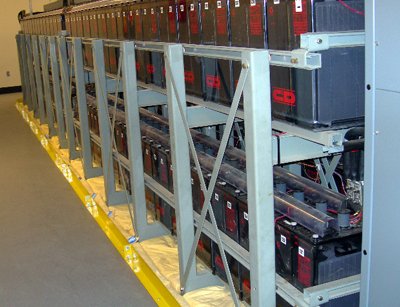Dr Ian Bitterlin, CTO, Ark Continuity: I read with increasing interest a report issued by the 451 Group on the future of battery autonomy time. It argues that new cloud businesses will be in need of less battery...
Bart Cotton, Chief Prognosticator, Intellibatt and IBM 1401 Restoration Team Specialist at the Computer History Museum: After decades of battery complaints – probably more so with VRLA (valve-regulated lead-acid) battery models – I find it comical that there is still a movement to eliminate the mainstay of backup power in the data center industry. I suspect the flywheel manufacturers have attacked this market for market share, especially on this side of the pond – “merican” as you say. This is coupled with a dearth of knowledge of battery purpose and how they work when properly taken care of.
The old CBEMA (Computer Business Equipment Manufacturers Association) (ITIC) curve can be used for just about anything to prove that power conditioning can save equipment for the short duration, is statistically sound, and that we only need bridge time to generator power. Again, that will sell flywheel systems to those looking for the best low-bid solution without a lot of thought.
It is interesting that the bulk of the battery complaints come from those who will not make the investment to properly service and monitor the battery asset. I don’t think the battery is going away any time soon. This is really an economic issue, and I am not sure it is based on the real world of ‘mission-critical’, or whatever one chooses to call it.
Bobby Yatco, Senior Manager, facilities, DataOne Asia (Philippines): The flywheel, in my opinion, has still not reached the ‘perfect’ stage. I do not feel comfortable with big moving mechanical parts. Perhaps I would think twice if the wheels were made very small.
Brad Gibbs, Lead Data Center technician, Amway: I am very happy with our flywheels and have not had an outage at either of our two data centers since installing them seven years ago. Rather than maintaining and monitoring batteries, we spend that time and money performing quarterly maintenance and testing our generators.
The footprint for the flywheels is much smaller than what would be required for redundant 1200KVa systems, as well as the cost to maintain and replace batteries. The maintenance on the flywheels is minimal. We are just about to do our first bearing replacements on our three-year-old systems and have not encountered any issues up to this point.
As for the moving parts, the good flywheel manufacturers test their wheels for failure and design them for minimal impact. In my opinion, moving away from batteries was one of the best things we have done for our data centers. It has allowed us to provide 100% uptime for several years now.
Chris Johnston, Senior Vice President of Critical Facilities, and Chief Engineer, Syska Hennessy Group: There are places for both solutions, but we should view both with a critical eye.
We have been deluged the past few years with marketing hype about flywheels. Much of the hype has been based on the premise that flywheels are greener than storage batteries. This has been largely debunked since more storage battery content is recyclable than flywheel content, and since flywheel losses are greater than storage battery float charge energy.
If a few seconds of energy storage autonomy is all that is required, then a flywheel is a more space-efficient solution than storage batteries. Storage batteries must be sized for a minimum 7-10 minute autonomy on day one, since the initial voltage drop on discharge must not go below the UPS DC undervoltage trip point. However, a few seconds of energy storage autonomy is not adequate if the standby genset doesn’t crank on the first attempt.
With a flywheel for energy storage, the standby energy source capacity (read as generator set) should be increased so it can both supply the critical load and quickly recharge the flywheel. With only a few seconds of energy storage autonomy, the flywheel is depleted after one discharge, leaving the critical load at risk until the flywheel is recharged. Not so with a storage battery after a short discharge.
Dr Ian Bitterlin: I totally agree there is more than enough space in the market for both solutions, but my criteria isn’t based only on autonomy. My surprise was the 451 Group came to the conclusion that autonomy would get shorter, even though batteries are cheaper and give you more time.
Chris Johnston: The requirement for autonomy may be lower, but how to achieve it is solution-dependent. Fourteen-second autonomy with a flywheel assumes that standby power is available in 10 seconds or less. If it is, then all well and good; if it isn’t, you’ve lost the critical load. There is no margin for cycle-cranking an engine if it doesn’t catch in the first attempt.
Seven-plus minutes with a storage battery lets you cycle-crank an engine to the limit. This battery autonomy could be reduced if battery chemistry was improved to lessen the voltage drop immediately after the discharge begins. I sleep better at night if clients have well-maintained and managed storage batteries.
Keith Klesner, Principal, Uptime Institute: The report is meant to highlight trends in the ever-changing IT industry. I share your view that many data center owners have an aversion to the short ride-through times of typical flywheel deployments. The choice comes down to, as Chris noted, helping the owner and/or operator sleep well at night. Deployments of flywheel energy storage in EMEA may be limited, but I do find a significant usage of DRUPS (diesel rotary uninterruptible power supply), which many operators have found to be acceptable.
Technologies in the data center are evolving. Convention is being rethought as leaders push the envelope with data center designs. UPSs, and their deployment methods are prime candidates for significant disruption that has, in many ways, already started.

